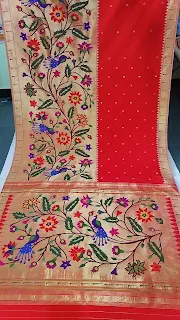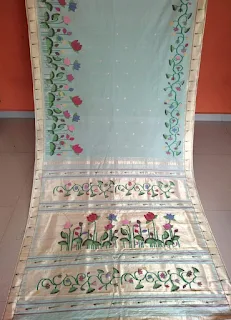Paithani Splendor: Unveiling Timeless Elegance with Rasa Reverie
Paithani Elegance:
Threads of Time and Traditions.
Origins and Rich History
The Paithani saree has a lineage that spans over 2500 years, tracing back to the Satavahana Dynastyin ancient India. Here are some fascinating historical tidbits:
• Birthplace: The saree originated in the medieval town of Paithan, nestled near Aurangabad in Maharashtra.
• Golden Era: During the Mughal era, especially under Aurangzeb’s rule, Paithani sarees flourished, adorning royalty and nobility.
Craftsmanship and Materials
Silk Threads:
◦ The foundation of Paithani sarees lies in fine silk threads. These are meticulously chosen for their texture and durability.
◦ The softness and drape of Paithani sarees owe much to this high-quality silk.
◦ Gold and silver zari threads are woven into Paithani sarees, adding opulence and grandeur.
◦ The intricate motifs—peacocks, lotuses, parrots, flowers, and vines—come alive with these precious threads.
Butta Motif:
◦ The hallmark of Paithani weave is the “butta” motif—a fusion of intricate paisleys and geometric shapes.
◦ These motifs adorn the saree, creating mesmerizing patterns.
Varieties and Designs
Borders and Pallu:
◦ The saree features oblique square borderswith intricate designs.
◦ The padar (pallu) often showcases a peacock design, symbolizing grace and beauty.
Colorful Kaleidoscope
Paithani sarees come in various varieties:
▪ Single-colored: Elegant and understated.
▪ Kaleidoscope-colored: Achieved by using different colors for weaving lengthwise and widthwise.
▪ Spotted designs: Playful and vibrant.
Precious Zari: Gold and Silver
◦ Gold Zari (Zardosi):
◦ The pallu and border shimmer with pure gold zari threads.
◦ These threads were once exchanged for gold by the Greco-Romans 2000 years ago.
◦ Silver Zari:
◦ Alongside gold, silver zari also graces Paithani sarees.
◦ The silver motifs create enchanting patterns.
Legacy and Reverence
• Dev Vastra: Paithani sarees are often called “Dev vastra”—fabric of God.
• Peshwa Patronage: In the 18th century, the Peshwas cherished Paithani textiles.
• Nilofer’s Influence: Legend has it that the Nizam of Hyderabad’s daughter-in-law, Nilofer, contributed new motifs to Paithani designs.
Modern Paithani
• Pure Silk: Present-day Paithani sarees are woven entirely from pure silk.
• Yeola: The town of Yeola, in Maharashtra, is now the largest manufacturer of Paithani sarees.
Adorning Elegance
Paithani sarees aren’t just garments; they’re a celebration of heritage, craftsmanship, and timeless beauty. When you wear a Paithani, you carry centuries of tradition gracefully.







































Comments
Post a Comment